OTHER RESOURCES
Some of this information is from the Blue Book of Aviation, Roland W. Hoagland, Ed., published in 1932 by The Hoagland Company, Publishers, Los Angeles, CA. 292 pp.
---o0o---
Thanks to Guest Editor Bob Woodling for help researching this page.
---o0o---
The University of Wyoming holds a collection of Williams' materials described as follows. The link takes you to the finding aid for the collection
"Collection contains materials relating to Williams's aviation career, including blueprints for an Aerocoupe designed by Williams for Yankee Aircraft Corporation; correspondence regarding Williams's flight to Rome, his book Flying to the Moon and Halfway Back, and the Roger Q. Williams School of Aeronautics (1928-1949); newspaper clippings; miscellaneous materials relating to the Roger Q. Williams School of Aeronautics; scrapbooks; stunt flying advertisements; pilot log books; certificates, awards and medals; artifacts; and sketches of Williams and various aircraft. There are also numerous photo files featuring noteworthy aviation persons, places, and things."
YOU CAN HELP
I'm looking for information and photographs of this airplane to include on this page. If you have some you'd like to share, please click this FORM to contact me.
---o0o---
SPONSORED LINKS
HELP KEEP THESE WEB SITES ONLINE
FOR YOUR CONVENIENCE
You may NOW donate via PAYPAL by clicking the "Donate" icon below and using your credit card. You may use your card or your PAYPAL account. You are not required to have a PAYPAL account to donate.
When your donation clears the PAYPAL system, a certified receipt from Delta Mike Airfield, Inc. will be emailed to you for your tax purposes.
---o0o---
ROGER QUINCY WILLIAMS
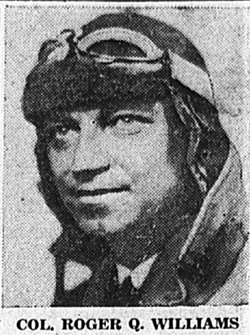 |
Roger Williams is signed in the Pitcairn Field Register once, on Wednesday, August 2, 1939. He flew the aircraft he identified as NC20608, a Fairchild 24J (S/N 3510). Based at Reader's Digest, NY, he carried two unidentified passengers. Their destination was cited as Pottstown, NY. "Good ol' Paul" was written cryptically in the remarks column of the Register. I have no information about who "Paul" was. For specific information about PItcairn Field, please click over to the HOME page linked at upper right.
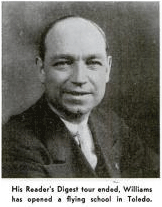 |
About this time, Williams was in the employ of the Reader's Digest Company. He had been hired to spread the gospel about aviation around the country during the late 1930s. He did so by flying the Fairchild from place-to-place, offering free rides to any and all comers. He also met with city planners and other public officials, and gave popular speeches and seminars about general aviation and the importance of aviation in the future. His Reader's Digest program was featured in the October, 1940 issue of the magazine Flying & Popular Aviation (F&PA). This three-page article is available as a PDF download (1.3 mB) at the link. Photograph, left, from the article. The article also posted a photograph of his airplane, along with some of the people to whom he offered rides. At the time of the article, his tour for Reader's Digest had just ended, so he was probably engaged in his tour when he flew to Willow Grove and signed the Pitcairn Field Register.
According to the Blue Book of Aviation (cited, left sidebar), Williams was born April 30, 1892 in Brooklyn, NY (this 1940 REFERENCE, p. 468, cites his birth date as 1894, but see his draft card, below). He learned to fly at Stratford, CT in 1914 and, by 1932, had accumulated 7,500 flight hours, including (?) his time in the air service during WWI. The Blue Book states that he, "served in the U.S. Army air service" during WWI, but does not say in what capacity (the linked REFERENCE also says nothing about military flying). His June 4, 1917 draft card, front and back, is below. Note that he was of medium build and height with gray eyes, brown hair and he was not yet bald. He worked as a "Mechanical Expert 7" for the G.C. Valentine company in Rowayton, CT. Guest Editor Bob Woodling (linked above) suggests the following about "G.C. Valentine," "The G.C. Valentine on his WWI draft card is likely Grace C. Valentine, widow of Henry C. Valentine, retired president of the Valentine Paint Co. (named Valspar today). The address on the draft card is Tokeneke Park, near Darien, CT, where the Valentines made their residence after Henry retired. By the 1910 census they are shown living there with servants and a chauffeur named Rosman Williams. Henry C. Valentine died in 1912, so it looks like Grace may have still been maintaining the house in 1917 when Roger Q. listed his occupation as a mechanical expert (maybe he was in charge of maintaining the house?)."
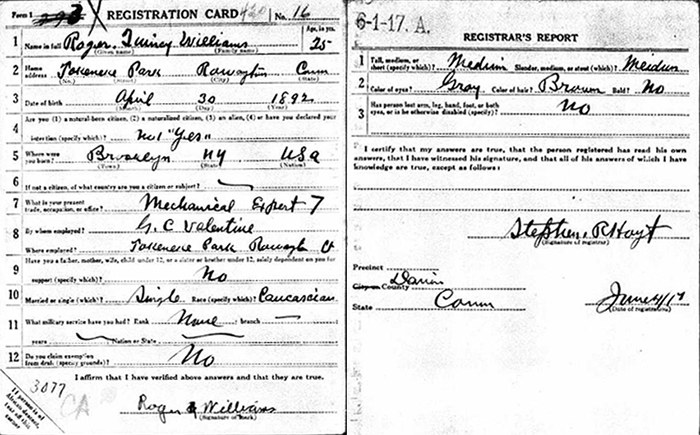 |
As with many things, the details are in the fine print. If you look carefully at the diagonal printing at the lower left of this card, the text says, "If person is of African descent, tear off this corner." Some things change; some things remain the same.
Many men of Williams' demographic cohort were subject to the drafts for both WWI and WWII. His WWII draft card it below, issued in 1942. He was 49 years old.
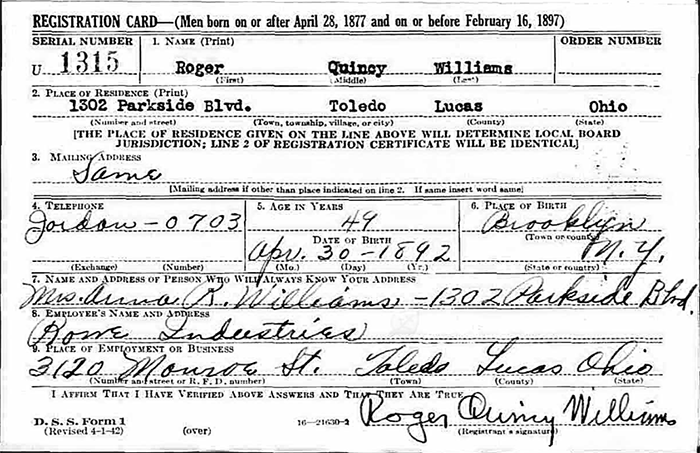 |
Between the wars, Williams was accomplished. He was a trans-Atlantic flyer and engineer. He was a well-educated and significant VIP Golden Age aviator, although his name was not as well-known as Jimmy Doolittle, Charles Lindbergh or Amelia Earhart. He probably didn't have the marketing engine, or, in the case of Doolittle, the military record, behind him that they did. He flew with Transport certificate T300, a very early number.
Besides U.S. Census data, the earliest flight information I have about him is a U.S. immigration report dated May 1, 1930, below. Williams flew the Columbia Triad NR375N from St. Hubert, Quebec, Canada to Albany, NY. He carried Albert Blumenthal as his mechanic. He cited 6,600 flight hours at this time. He must have flown another 900 hours to have his total time equal 7,500 hours as stated in the 1932 Blue Book, a distinct possibility.
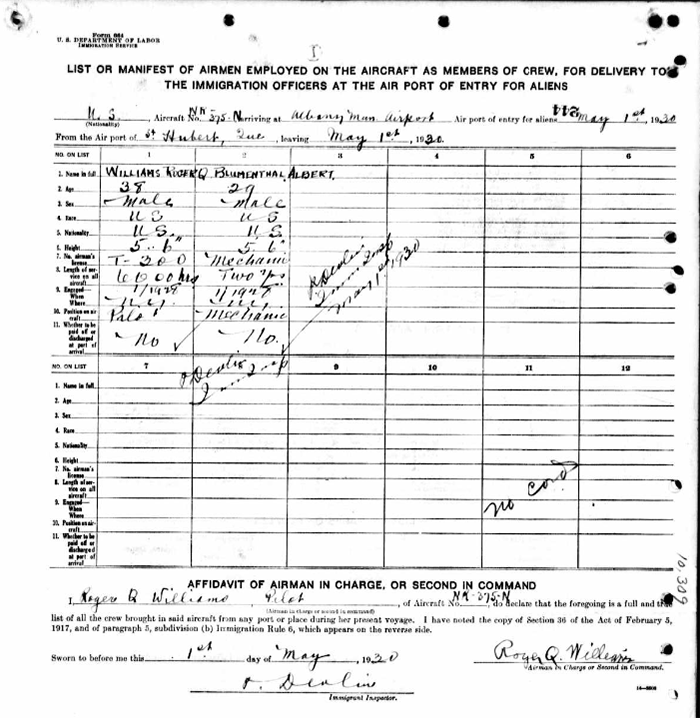 |
Aerofiles.com describes the Triad as, "An amphibian converted to a landplane by detachable hull, or to full seaplane by removal of the wheels." Two examples were manufactured. Further, "Both were destroyed in a hangar fire on 1/19/31. Registers also show a [X375N] c/n 3 as a Triad, but without data or explanation of its presence." No reason was given for this flight, but it was probably a ferry.
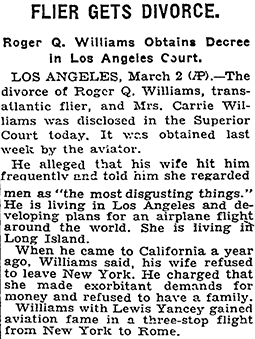 |
According to the 1940 REFERENCE linked above, Williams was educated at Harvard and Columbia Universities, 1914-16; The Massachussetts Institute of Technology, 1917, and Princeton University, 1918. Despite the top universities, he only completed three years of engineering education and did not receive a degree or certification in engineering (stated in his 1949 book, below).
He married Carrie Tiemeyer (b. 1894) on July 24, 1918 in Manhattan, NY. The 1920 U.S. Census shows his wife, Carrie (age 25) living on Freedom Avenue, Queens, NY with her mother and a lodger, Bernedetta Morgan. Carrie is cited as a clerical worker in a book bindery. Williams is not living with them. Separately, he is listed in the 1920 Census living as a boarder in Mt. Vernon, NY. I do not know why he was living separately just a few tens of miles north of Queens.
Ten years later, the 1930 Census, recorded April 15, 1930, places Williams (age 39) living in Queens, NY with Carrie (36), mother-in-law Caroline Tiemeyer (64) and a lodger, Bernedetta Morgan (37). His occupation was listed as "Aviator" for a "Private" concern.
A year later he divorced Carrie T. Williams as reported in The New York Times (NYT) of March 3, 1931, right, with allegations of cruelty. This article pinpoints his move to California.
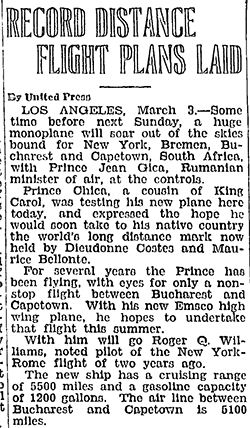 |
His purpose for being in California was allegedly (see below) to prepare for the flight described in the article at left from the Berkeley Daily Gazette of March 3, 1931 (coincidentally published on the same date as his divorce notice in the Times). This same article appeared in the San Jose News (CA) of March 2nd.
Williams had accepted employment with the Emsco Aircraft Company in Downey, CA in 1930. He was the manager of the operation from 1930-1932. The airplane that he and Prince Jean Gica intended to fly to South Africa from Rumania was a large, high-wing Emsco transport aircraft. I could find no information about further plans for the flight, but according to the article below, left, it was a "mistaken idea" and never carried out. However, he was a part of the rollout of a new sport model Emsco, the B-10, as pictured in the Times article below. NX909Y can be found listed three times in the Register of The Grand Central Air Terminal. Unfortunately, the name(s) of the pilots were not identified.
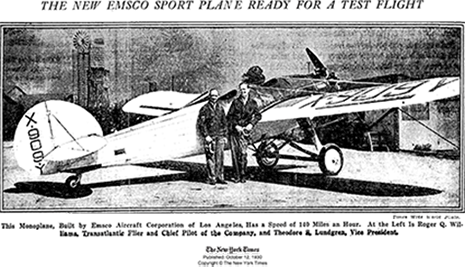 |
Williams' troubles with Carrie weren't over with their March divorce. He was arrested May 8, 1931 and sent to county jail under a bail of $2,000. His arrest and a description of the circumstances were documented in The New York Times of May 9, 1931, below left. He posted bond and was released in a few days. In August a judge stayed Carrie's demands for a month, because Williams pleaded, "I am practically destitute and have a number of debts."
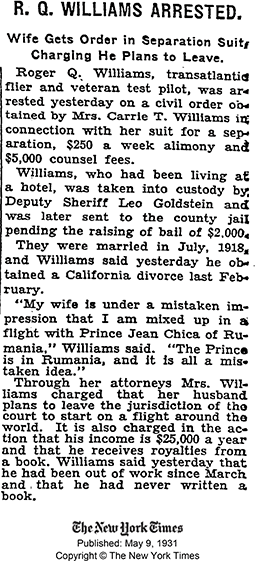 |
But, two months later, The New York TImes of November 7, 1931 reported that Carrie won a court order to tie up his personal property in an attempt to gain $685 in alimony and $250 in counsel fees allegedly owed to her.
His financial troubles continued and finally led him to bankruptcy proceedings six years later, as reported in the Times of March 21, 1937. He listed $4,979 in liabilities and no assets. His obligations to Carrie, as well as the Great Depression, contributed to his trouble making ends meet.
But then there were his accomplishments in the air. In 1919 he flew four miles upside down. During the late 1920s, he established a 51 hours 52 minutes non-stop, unrefueled, American endurance record with Register pilot Clarence Chamberlin as copilot in January, 1928. Interestingly, this was not a world record, falling an hour short of the record set by German flyers. But his flight was made on the shoulders of three earlier attempts that failed because of, usually, mechanical problems.
This flight and the pilots were very popular with the citizens of the greater New York area. After their flight, tens of thousands of people would come to Floyd Bennett Field and pay for rides with them. For many it was their first ride aloft, and many became the passengers for future air transport flights. During one year, he allegedly held a record for flying 2,100 hours in twelve months. That works out to about six hours of flying per day, every day of the year. If true, this is a prodigious accomplishment.
In 1929, he made a non-stop trans-Atlantic flight from Orchard Beach, ME to Spain with Peterson Field Register pilot Lewis Yancey (1895-1940) as navigator. They continued on to Rome, becoming the first aviators to fly from the U.S. to that city. Their airplane was the Bellanca NX3789, a J model, S/N 101 (not a Register airplane). It was named "Pathfinder." There is a photograph of Pathfinder on pages 101-102 of Williams' 1949 book, described below.
This flight was a big deal. He was awarded the Grand Master of the Order of the Crown of Italy by then King Victor Emanuel, and the Gold Medal of the Minister of Aeronautics of Italy by then Premier Benito Mussolini. And the Vatican bestowed a Special Decoration on him. Various photographs of Williams, Yancey, the King, Mussolini and the Pope are on the Web.
There were many news articles in the U.S. and abroad generated from this flight. They included a long list of articles that described the many weather delays endured before their final departure (over a week of fog, rain and ice), test flights, articles describing their welcome in Rome, and many articles documenting their arrival back in the U.S. One entry at ancestry.com shows the U.S. immigration listing for his and Yancey's return to the U.S. aboard the S.S. Republic on July 28, 1929,
There were tens of articles about the Rome flight in The New York Times alone. Even news articles about other pilots included Williams' name. He was routinely mentioned as part of the greeting committee for other record-setting pilots (Earhart, Hughes), a dinner attendee, or in some other capacity. His reputation for this one flight followed him for at least the next two decades. A brief film of the Willams/Yancey greeting in Rome is at the link.
An interesting finding was this 3"x5" card file for Associated Press, Name Card Index to AP stories related to Williams in the news. I have arrayed these 29 cards in a PDF file you may download at the link (1.7mB). Card number one is displayed below. These cards summarize briefly many of the news articles exhibited on this page, as well as others. The file is a nice chronology of news coverage of Williams between 1927 and 1938. It is a good, candid window into the frustrations and tribulations of one long-distance flyer during the Golden Age, as documented for the Associated Press.
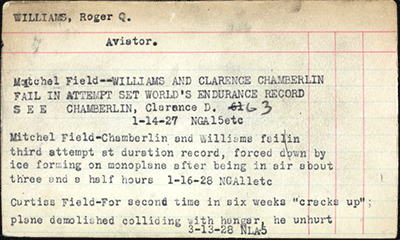 |
 |
For perspective, trans-ocean flying was relatively new, being only a decade or so old in 1929. The U.S. Navy flew Curtiss NC aircraft, and Alcock and Brown flew a modified Vickers Vimy bomber, across the Atlantic in 1919. The Round the World flyers flew significant portions of their flights over oceans in 1924. Lindbergh flew the Atlantic solo during May, 1927. On June 4, 1927, Clarence Chamberlin and Charles Levine flew from New York to Eisleben, Germany. A couple of months later, during July and August, three flights were made across the Pacific from California to Hawaii. From the late 1920s on, it seemed every pilot wanted to try a trans-ocean flight. The scramble for suitable airplanes, sponsorship and cash deals only increased as the Great Depression deepened during the 1930s.
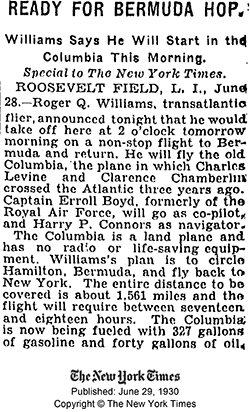 |
In 1930, Williams made a non-stop, round trip flight from New York City to Bermuda. The flight was described in the Times of June 29, 1930, left. He departed New York at 5:00AM and, after circling Hamilton, Bermuda without landing, he returned to New York at 10:03PM.
His flight was a harbinger of things to come. On June 16, 1937, Pan American and British Imperial Airways inaugurated flying boat flights from New York to Hamilton. The one way duration of the flights was 4.5-5.5 hours. It was the first time commercial aviation was scheduled from the U.S. to Bermuda, some seven years after Williams' round trip.
Twenty-one years later, the Times of March 18, 1951 reported record ticket sales for the New York to Hamilton run, with 12,000 persons carried on the route during the Easter season. The three airlines on that route at the time were Pan American World airways, Colonial Airlines and Trans-Canada Air Lines. None of these are in service in the 21st century.
Williams came to grief after that flight after the Department of Commerce (DOC) suspended his pilot certificate for ninety days for flying, "... without first obtaining the permission of the Governor of Bermuda to fly over the island...." Register pilot Gilbert Budwig, then head of the aviation section at the DOC, came to his defense and his certificate suspension was reduced to a week. The article, right, from The New York Times of July 30, 1930 describes the incident and the resolution.
Just before his Bermuda flight, The New York Times of June 6, 1930 reported that Williams flew the radically-designed flying fuselage monoplane manufactured by the Uppercu-Burnelli Corporation at Newark Metropolitan Airport. Be brought the new, twenty-passenger craft to Roosevelt Field on Long Island. This innovative and safe design never made it into meaningful production. You can download at the link above an 11-page description of Bernelli's work and his aircraft, including a bibligraphy (PDF 979kB).
In what could be construed as an attempt to foil a legitimate Canada to London crossing of the Atlantic by other pilots, Williams brought suit against the owner of the airplane. Allegedly Williams was owed salary of $801 that hadn't been paid by that owner. The airplane was seized in Montreal. The article in the Times of September 3, 1930 describing the incident did not state a resolution to the suit. Then the Times of September 12th reported the suit was quashed in Canadian courts due to "lack of jurisdiction." The flight was on again. But, the Times of September 18th reported the cancellation of the flight. The flight was finally made, successfully, in October. An example of the on again; off again nature of trans-ocenanic flights in the 1930s.
On the heels of his successful Bermuda round trip, Williams' suit probably did nothing to endear him to the trans-oceanic pilot community. What made it worse was the navigator of the cancelled flight had navigated for Williams on his Bermuda flight (Harry P.M. Connor [d. 1959], mentioned in the article, above, left; last name misspelled). Incidentally, Connor was also the navigator for Howard Hughes during his 1938 global flight. Please direct your browser to Hughes' link over on the Clover Field Web site for information on that flight, and a photograph of Connor (note his mis-buttoned suit coat before that long flight).
Earlier, in April, 1930, Williams initiated another suit that led to the arrest of principals of Hadley & Company, New York City investment brokers. It seems Hadley had misrepresented agreements by another company Williams was involved with, Airvia, that was part of the Crescent Aircraft Company owned by Clarence Chamberlin. In order to sell securities in Airvia, Hadley misrepresented the magnitude of contracts for airplanes ordered from Crescent. This suit was cited by the Times on April 26, 1930. The suit was further developed and details published in the Times of August 17, 1929.
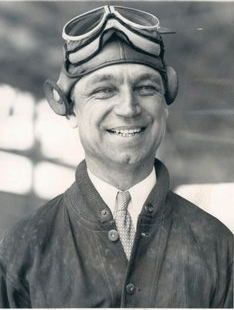 |
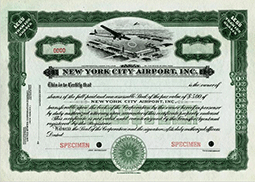 |
Another legal incident was published in the Times of June 12 and 17, 1931. A company, New York City Airport, Inc., was under scrutiny by state and federal officials for possible mail fraud in the sale and distribution of securities related to the company. Williams was a director of the company, since resigned. He and over a dozen other officers and directors were under subpoena to testify. The company developed a 300-acre field between Flushing and College Point in Flushing, Long Island, New York called Flushing Airport. The company was investigated for not only allegations of mail fraud, but also of theft and accounting irregularities. The airport opened in 1927 and closed in 1984.
Photograph, left, was snapped at Floyd Bennett Airport, New York, July 8, 1932 before attempting a non-stop flight to Greece. He was to fly with Mrs. Elvy Kalep Miller as co-pilot according to an August, 1932 article in the Times. Then a September article stated he was to fly to Athens with Otto Hillig, a photographer from Liberty, NY. Hillig was a creditor for the plane Williams intended to fly. He sought out Williams and Miller before they departed, because Williams still owed Hillig $500 against the aircraft. Perhaps the substitution of Hillig for the flight was part of an agreement in lieu of cash. Regardless, I could find no information that showed Williams completed that flight.
However, a June 2, 1933 article in the Times discussed plans for a round-trip flight to Rome via the southern route, with a stop in Athens before return to the U.S. by the northern route. If these flights were one and the same, I found no evidence either was completed.
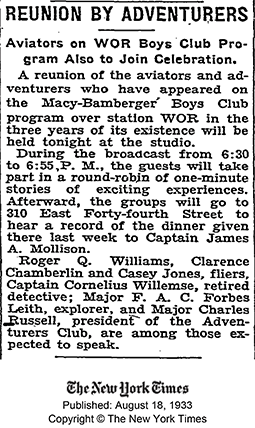 |
Do you notice a pattern here? Unexecuted flight plans; lawsuits; unstable or questionable businesses. Numerous articles referred to "planned" flights or aborted flights (see Associated Press card file, above). It seems only a few were ever completed.
Besides the examples above, other articles referred to a numerous "new" businesses that Williams had a hand in. For example, the Times of January 29, 1933 described a new air transport company that proposed to fly passengers throughout New York and New England. It was called New York & New England Airways and flew passengers, for example, from New York to Hartford, CT for $5.00 round trip. It passed its 15-day trial period, stock was issued, but the line was short-lived.
Despite lawsuits and failed start ups, Williams was a contributor in the aviation business world. Besides his leadership of Emsco cited above, in 1937 he was elected to be a director and technical advisor to the Porterfield Aircraft Corporation, Kansas City, MO. Earlier he was a pioneer constructor and test pilot for the Scientific Aeroplane Company from 1914-1917. From 1917-1919 he flew for the military. After that he was a barnstormer, stunt and test pilot and aircraft production manager and executive from 1919-1927. He was chief instructor for the Curtiss Flying Service (on Long Island?) from 1927-29. He was a consultant and technical advisor to South American and U.S. governments, the City of New York and various aircraft firms from 1932-1936. He also served as an aviation lecturer and featured guest in various venues. An example from 1933 is at right from the TImes of August 18, 1933. From 1937-1940 he organized and flew the Reader's Digest tour, which brought him to our attention at Willow Grove on Wednesday, August 2, 1939.
In the limelight of his trans-oceanic experience, Williams and a few other trans-oceanic flyers banded together in 1932 to form a flight school for those with long-distance flight intentions. The New York Times of May 1, 1932 described the program, below.
 |
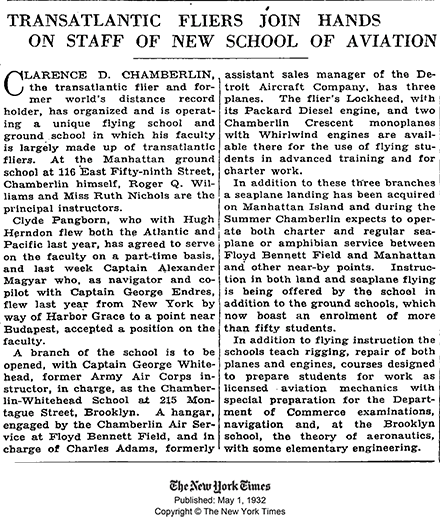 |
This school was unique in that most of the instructors and officers were experienced with ocean flying. Chamberlin, Ruth Nichols, Clyde Pangborn and Hugh Herndon were all Register pilots.
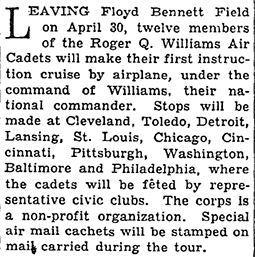 |
Part of his activity during 1934 was the organization and instruction of the Roger Q. Williams Air Cadets. The Times article at left documents plans for a cross-country tour of the northeastern U.S. by a dozen of his Cadets. I found no follow-on articles that documented the execution or success of this tour.
In 1938 Williams wrote then New York Mayor LaGuardia about the conditions at the new North Beach Airport program. The New York Times of August 29, 1938 reported on the project, above, right. North Beach Airport would be developed and its name would soon be changed to LaGuardia Airport.
 |
 |
According to several sources, he established The Roger Q. Williams School of Aeronautics and the Williams Aircraft Corporation. I could find no information about exactly when they were formed, or where, or the types of products and services they offered. However, in the late 1930s he continued on the speaking circuit, right and left.
The 1940 U.S. Census placed him at age 47 living in Queens, NY with his wife, Anne (age 35), daughter Audrey (13) and son Roger, Jr. (4). They rented their home at 3716 83rd Street for $50 per month. His employment was listed as "Aviator" for "Reader's Digest." I do not know when he married Anne. Audrey would have been born ca. 1927 when he was married to Carrie.
Late in WWII, Williams was part of the start up of National Airports, Inc., a new organization to act as an umbrella control point for a chain of national airports. Williams was chairman of the board for the new organization. Notice that this organization was formed, with confidence, a full ten-months before the formal end of WWII as an instrument to regulate post-war civil and military air traffic. At the time of this article, Williams was the leading officer in his own Williams Aircraft Corporation in Toledo, OH. The photo of Williams must have been a file shot used when he appeared in the news.
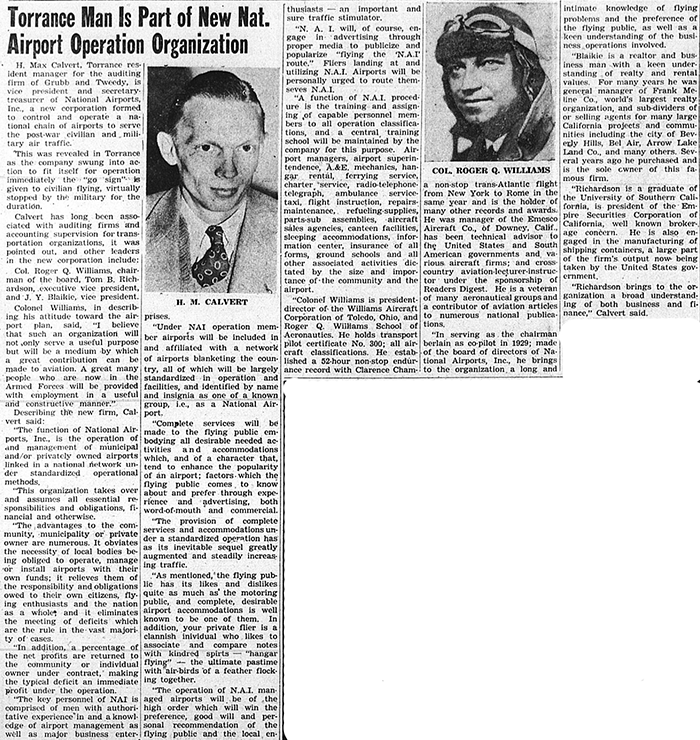 |
He moved around during the 1940s and 50s. The city directory for San Leandro, CA lists him in 1956 living at 343 Foothill Blvd. with Anne and working as an engineer for the Naval Air Station. Roger, Jr. is listed below him in the directory and was a "student" living at the same address.
Besides his U.S. Transport certificate, he held F.A.I certificate no. 1682. He was a member of the Quiet Birdmen, National Air Pilots Association, International League of Aviators, World Flyers, American Legion, Chicago Press Club, Royal Aero of Italy, National Parachute Jumpers Association and he was a Mason.
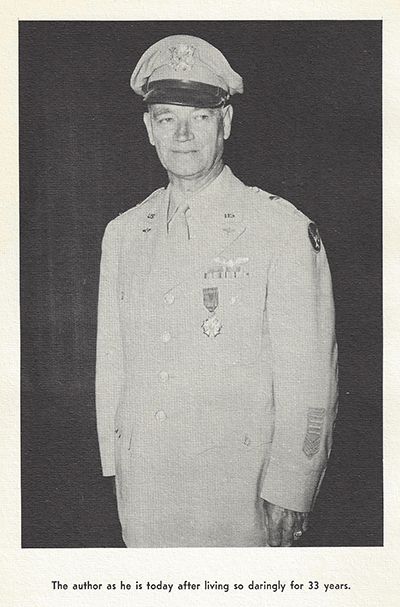 |
The University of Wyoming holds a collection of Williams' materials (link to finding aid, left sidebar), including his pilot log books. These logs undoubtedly include a record of his landing at Pitcairn Field. At the U.S. Air Force Academy in Colorado Springs there is a scrapbook of newspaper clippings on Lewis Alonzo Yancey and Roger Q. Williams' 1929 trans-Atlantic flight. Based on my research, that scrapbook is probably quite full.
In 1949 he published a book entitled, "To the Moon and Halfway Back." Photograph, left, is from the fronticepiece of his book and shows him in WWII uniform. After an unctuous, personal introduction ("the boy had a dream" and "our young hero"), this 292-page book presents a cursory history of early aviation, which includes the checklist of early flights, pilots and air shows. The impact of Lindbergh's 1927 flight on the world population was described as, "The drama of his adventure set their heartstrings vibrating in high pitch, as a horsehair bow to a violin string."
Chapters 7 & 8 span thirty pages and cover Williams' Bermuda and trans-Atlantic flights. Many photographs show the airplane, "Pathfinder," and the pilots and crowds on the ground.
Further, if you click the link in the left sidebar to the finding aid for his University of Wyoming collection, you will find that he wrote many published and unpublished manuscripts, among them children's stories. He wrote for Aero Digest, Sportsman Pilot, Argosy, N.Y Daily News, The Glider, Reader's Digest and Psychology Digest. For the latter, in March, 1937, he wrote, "Are Women Psychologically Unsuited for Flying?." I have not read that article.
Williams also landed at least once, on Sunday, March 22, 1931, and is signed in the Grand Central Air Terminal Register at the link. He flew an Emsco airplane, NC869N. He has a reasonable Web presence with mostly biographical entries. He passed away on August 12, 1976 at Alameda, CA. He was 84 years old. Oddly, I could find no obituary for him or for Anne. First wife Carrie died April 18, 1981 of renal failure in Brattleboro, VT. She was still divorced at the time of her passing.
---o0o---
SPONSORED LINKS
THIS PAGE UPLOADED: 01/05/16 REVISED:
